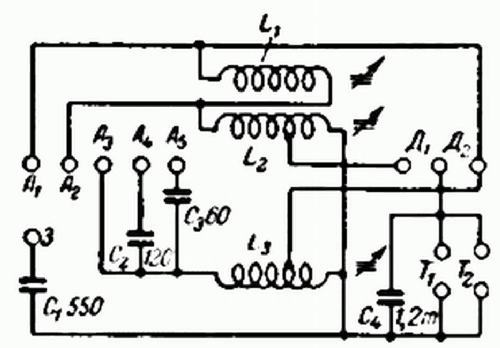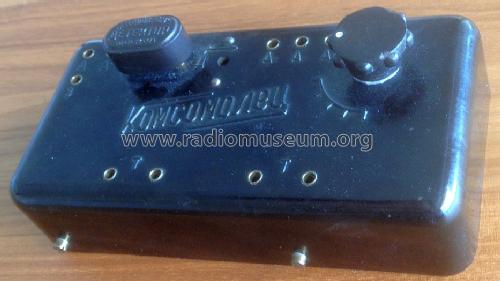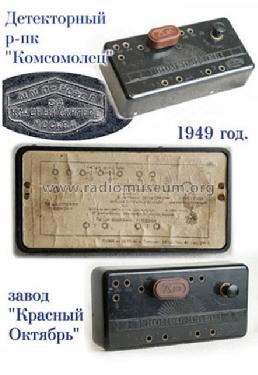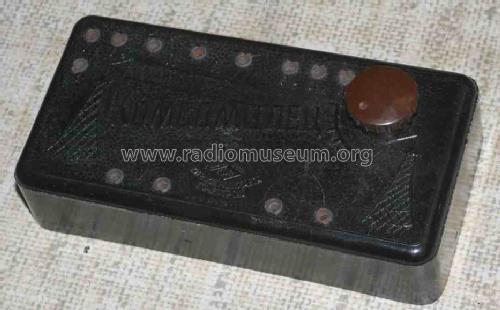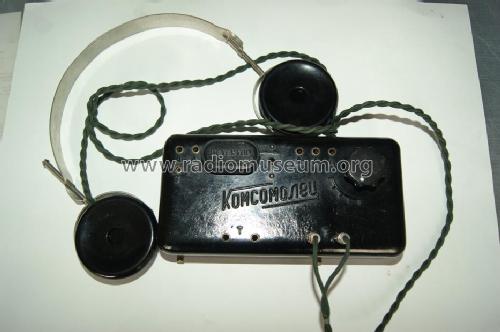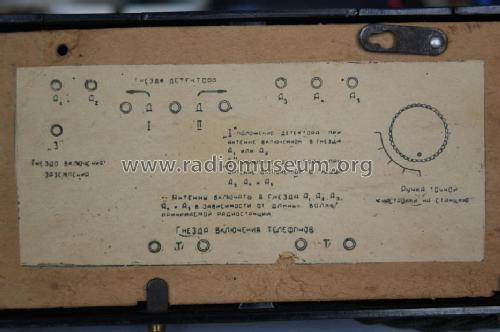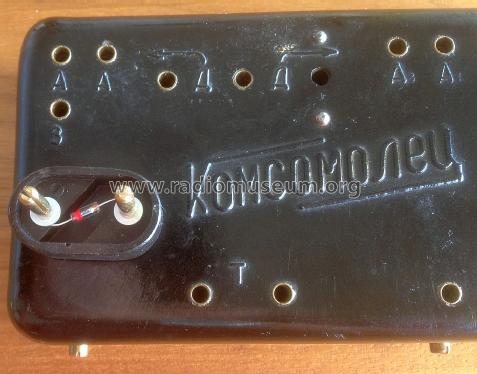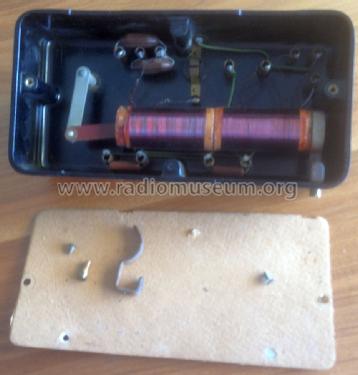Komsomol {Комсомолец} (детекторный радиоприёмник)
Radiofront Plant, Moscow
- Paese
- Unione Sovietica
- Produttore / Marca
- Radiofront Plant, Moscow
- Anno
- 1951–1957 ?

- Categoria
- Radio a galena (a cristallo o a diodo, senza valvole o transistores)
- Radiomuseum.org ID
- 253100
Clicca sulla miniatura dello schema per richiederlo come documento gratuito.
- Principio generale
- Rivelazione a galena / semi-conducteur; Rivelazione a galena, 1 circuito RF
- N. di circuiti accordati
- 1 Circuiti Mod. Amp. (AM)
- Gamme d'onda
- Onde medie e lunghe in una sola gamma.
- Tensioni di funzionamento
- Alimentazione non richiesta
- Altoparlante
- - solo per cuffie o auricolari
- Materiali
- Bachelite
- Radiomuseum.org
- Modello: Komsomol {Комсомолец} - Radiofront Plant, Moscow
- Dimensioni (LxAxP)
- 180 x 42 x 90 mm / 7.1 x 1.7 x 3.5 inch
- Annotazioni
-
"Komsomolec" produced in others SU factories too. Made about one million sets total.
Wikipedia in Russian (just the Google translation, sorry): Soviet radio detector, manufactured by several companies from 1947 to 1957, one of the most common and probably the last in the USSR serial receiver in this class. Designed by the engineer SRI MPSS MR Kaplanov in the contest for a cheap receiver mass conducted in 1947 by the Ministry of Communications Industry of the USSR. Design and features
Receiver "Komsomolets" is designed to receive broadcasting bands long and medium waves (from 200 to 2000 m) in the high-impedance headphones with an external antenna and ground. In the resonant circuit of the receiver is no variable capacitor. Adjustment is made connecting the antenna to different conclusions and smooth contour of the coil inductance change - it moves inside the core of alsifera. The receiver is designed to connect an external silicon detector, designed as a plug and piezoelectric headphones (supplied). Housing made of karbolit. There were at least two different forms of embodiment of the housing.
Dimensions without detector - 180 × 90 × 42 mm, weight - 350 g
"Komsomolets" produced at least seven factories and cooperatives in Moscow, Kaliningrad and Perm. Its price was about 40 rubles, the monthly fee for the use of a crystal set in the 50s was 5 rubles. per year (on a scale of prices to a monetary reform in 1961)."See also probably the first series here. This later edition can be found with small differences depending on the manufacturer and time.
- Peso netto
- 0.350 kg / 0 lb 12.3 oz (0.771 lb)
- Autore
- Modello inviato da Ernst Erb. Utilizzare "Proponi modifica" per inviare ulteriori dati.
- Altri modelli
-
In questo link sono elencati 3 modelli, di cui 3 con immagini e 3 con schemi.
Elenco delle radio e altri apparecchi della Radiofront Plant, Moscow
Collezioni
Il modello Komsomol {Комсомолец} (детекторный радиоприёмник) fa parte delle collezioni dei seguenti membri.
Discussioni nel forum su questo modello: Radiofront Plant,: Komsomol {Комсомолец}
Argomenti: 1 | Articoli: 2
This is only a Google translation from the site: sstu.ru/museum-radio
for enabling owners to understand the usage of the set more precise:
"Recommended dish: outdoor, with a total length of 40-50 m and a height of suspension of at least 10 ... 16 m antenna wire that fits the receiver is embedded in a single-pole plug, plugs into the A-1, A-2, A-3 , A-4 or A-5 depending on the length of the received radio wave. As used sheet metal grounding size 60x60 cm or more, buried in the ground to a depth of 1 m from the ground wire is embedded in a single-pole plug, this plug must be inserted into the slot 3. Headphones applied piezoelectric or electromagnetic type. Plug from the headphones are inserted into the slot T.
For preliminary rough adjustment of the receiver on the radio, plug the antenna wire and the detector is inserted into the corresponding slots top of the receiver. If the plug to the antenna wire is inserted into the socket A-1, A-2, then the detector should their forks inserted into the left two detector slots 1 and 2; if the plug to the antenna wire is inserted into the socket A-3, A-4 and A-5, the detector need to rearrange the right pair of detector sockets 2 and 3. Fine tune the station achieved slow rotation knob associated with alsiferovym core. When turning this knob to tune in a station, running about in the following waves: From 2000 to 1100 m, spruce plug the antenna wire is inserted into the socket A-1, from 1200 to 670 m in A-2, and from 800 to 470 m A-3, 570 to 340 m in A-4 and 350 to 250 m in A-5. Recommendation is valid for the above antenna. To receive the Moscow radio stations operating at wavelengths 1724 and 1293 m, plug the antenna wire should be inserted into slot A-1 and slowly change the setting until the best hearing in the headphones received station."
Ernst Erb, 16.Jun.14
